Applying management frameworks from a hundred years ago to organizations that need to compete in the digital age is futile.
From Project to Product — Mik Kersten [1]
Principle #10 – Organize around value
As described in the Business Agility article, successful enterprises don’t start out as large and cumbersome. Typically, they begin as a network of people cooperating to address customer needs. Structure and formality are unnecessary. People just naturally do whatever needs to be done. Focusing on the customer is natural, too, because without that, Darwinism takes hold and business failure is quick and catastrophic.
But as the enterprise grows and experiences success, it builds the organizational hierarchy needed to provide the time-tested management structures that will support operations, HR, finance, governance, and all the other corporate responsibilities of a functioning enterprise.
Over time, however, the work of the hierarchy overtakes the work of the entrepreneurial network. The result can be a seemingly decreasing ability to deliver the right products to the right customer at the right time. And success is no longer assured.
While leveraging the hierarchical system benefits and stability, the dual operating system model of Business Agility (Figure 1) instead restores the entrepreneurial network’s speed and innovation.
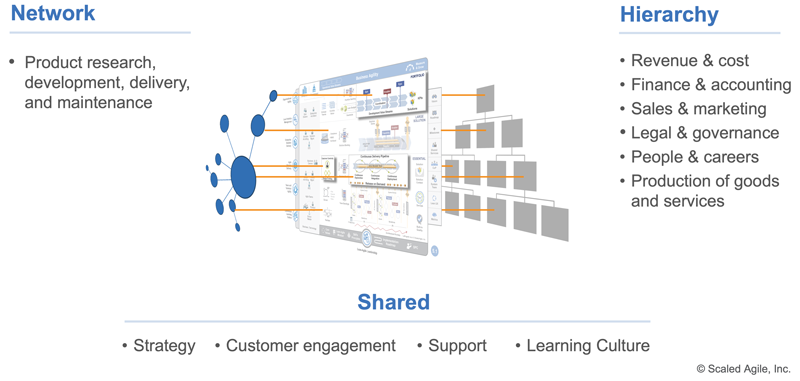
The Network is optimized for speed and adaptability; the Hierarchy is optimized for efficiency and stability. Both are necessary, valuable, and both must be Agile. But they are designed and optimized for different purposes.
SAFe implements the Network as a set of development value streams (DVSs) and provides the necessary interfaces to the Hierarchy to restore the system’s balance.
Freed from the reporting structure and the need for start-and-stop-projects, the network can now organize and reorganize as needed. By moving the focus from ‘project to product,’ [1] it rediscovers the customer focus and adaptability required to survive in the digital age. The Network optimizes the flow of value by:
- Reducing handoffs and delays between functional areas, reducing time to market
- Bringing together all the research, development, deployment, and service personnel needed to offer whole product solutions
- Providing intense customer focus across all disciplines for each product and service type
- Measuring success via meaningful, outcome-based key performance indicators
- And perhaps most importantly, the Network can rapidly reorganize as necessary to support emerging opportunities and competitive threats
How SAFe Organizes Around Value
This principle, Principle 10-Organizing around value, describes how applying this second operating system frees the enterprise to arrange itself to optimize value delivery. It accomplishes this in three nested parts:
- Build technology portfolios of development value streams
- Realize value streams with product-focused Agile Release Trains (ARTs)
- Form Agile teams that can directly deliver value
Each is described in the sections that follow.
Build Technology Portfolios of Development Value Streams
The key to unlocking this potential is to understand and apply the concept of value streams, which are fundamental to lean thinking. Lean thinking can be summarized as follows: [2]
- Precisely specify value by specific product
- Identify the value stream for each product
- Make value flow without interruptions
- Let the customer pull value from the producer
- Pursue perfection
This assures product and customer focus, as the value stream, product, and customer are inexorably linked. You can’t have one without the others.
Value streams are defined by the steps, the people, and the flow of information and material necessary to deliver customer value. Value streams optimize the flow of value across divisions and functional departments and through the system as a whole to the customer.
SAFe describes two types of value streams, operational and development. While the structure of operational value streams varies significantly based on the purpose and type of value delivered, the structure of development value streams has a standard form, as summarized in Figure 2.

Each SAFe portfolio consists of a collection of development value streams, aligned as necessary to deliver the products and services customers need (Figure 3). This allows the entire organization—from the building block of Agile teams to ARTs and Solutions Trains, to the entire portfolio—to organize for one purpose: delivering value to the customer as quickly as possible.
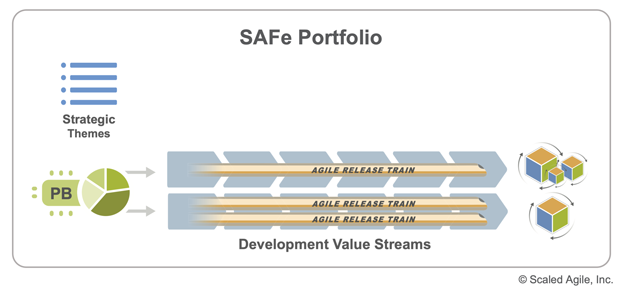
Organizing a portfolio this way offers many benefits:
- Helps assure customer and product focus across the entire portfolio
- Aligns strategy to execution by bringing visibility to all the work
- Provides the basis for Lean Budgets, which eliminates the friction and cost accounting overhead of traditional project-based work
- Supports measuring success via outcome-based key performance indicators (KPIs)
- Improves workflow with smaller batch sizes
Indeed, when you start to understand the value they bring to the enterprise, it makes one wonder how we ever got along without value streams. Yes, they were always there; we just didn’t see them. [2]
Realize Value Streams with Product Focused Agile Release Trains
The straightforward structure of development value streams begs the question: How do we reduce the time from feature request to delivery? Clearly, people and resources need to be organized to minimize handoffs, make the individual steps more efficient, and reduce the delays between them. That is the purpose of the ART, as Figure 4 illustrates.
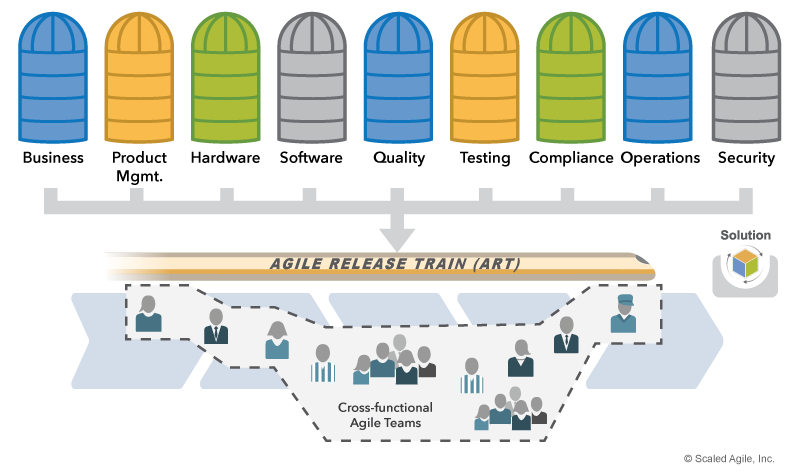
ARTs are cross-functional, cross-discipline teams-of-teams of up to 150 people. To minimize handoffs and delays—and to foster continuous knowledge growth—ARTs have all the business and technical capabilities needed to define, implement, validate, deploy, release and support solutions for their customers.
Scaling the ART into Solution Trains
In many circumstances, a single ART can deliver and support a significant product or service. When the solution gets bigger, however, the organization gets bigger, too. In this case, ARTs are assembled into Solution Trains capable of building ever-larger systems. To assist with this, SAFe suggests constraining the design options by applying three specific types of ARTs: stream aligned, complicated subsystem, and platform, as Figure 5 illustrates.

Form Cross-Functional Agile Teams That Directly Deliver Value
At the heart of this structure are the Agile Teams who build the system, the basic building block of all things agile. They constitute the majority of personnel on ARTs and their structure is well defined: each is a cross-functional group of 5-11 individuals who can define, build, test, and deploy an increment of value in a short time box. Like the ART, Agile teams are customer-focused, cross-functional, and have all the skills needed to deliver beginning-to-end value to the customer. (Figure 6)
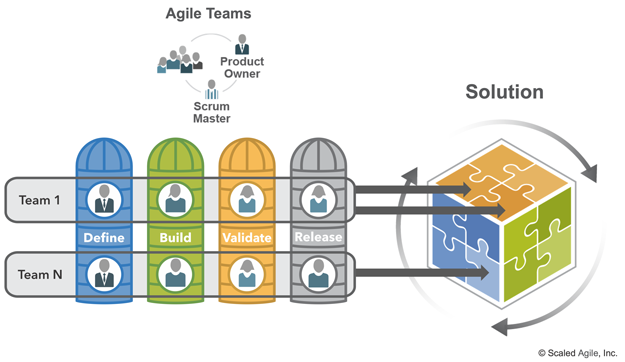
To limit cognitive load, Agile Teams are organized around one of four types of value: stream-aligned, complicated subsystem, platform, and enabling teams [3] (Figure 7).
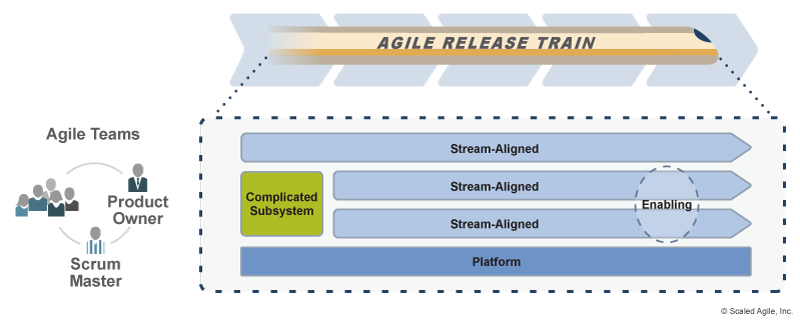
Most ART teams are stream-aligned, empowered, and capable of delivering value to their customers with a minimum of handoffs, delays, and dependencies with other teams. Other teams support stream-aligned teams in their mission.
(Note: For more on team and ART topologies, see Agile Teams, Solution Train, Organizing Agile Teams and ARTs, and reference [4].)
Reorganizing around Value
This principle highlights three specific organizational patterns—Value Streams, ARTs, and Agile Teams—that SAFe enterprises use to build the second operating system. This network is far more adaptable and can respond more quickly to market changes than the hierarchical system. People and teams can flex naturally to the demands of the incoming work without disturbing any of the reporting or other relationships present in the hierarchical system. And yet, even in a sea of constant change, the standardization these patterns provide adds structure, focus, and stability for the people who do this important work.
Value streams, ARTs, and Agile Teams live for as long as the solutions they develop and support thrive in the marketplace. But they are not fixed over all time. Some new value streams will be created, others will need to be adjusted, and some will be eliminated as solutions are decommissioned. In other words, when necessary, the Network can evolve very quickly, while the Hierarchy can remain relatively stable. (Figure 8)
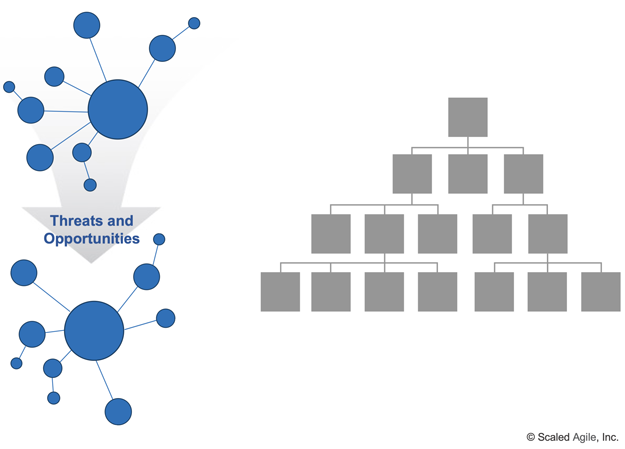
Fortunately, the people and teams of an increasingly Lean and Agile enterprise see those changes coming through the portfolio. As virtual organizations, they can quickly evolve in any combination necessary to respond to changing technologies, products, and market demands. In other words, as value moves, these organizations can move with it. Business Agility is the most important outcome.
Learn More
[1] Kersten, Mik. Project to Product. IT Revolution Press, 2018.
[2] Rother, Mike, and John Shook. Learning to See: Value Stream Mapping to Create Value and Eliminate Muda. Lean Enterprise Institute, 2018.
[3] Skelton, Mathew, and Manuel Pais. Team Topologies: Organizing Business and Technology Teams for Fast Flow. IT Revolution Press, 2019.
[4] Organizing Agile Teams and ARTs: Team Topologies at Scale
Last update: 21 July 2021


